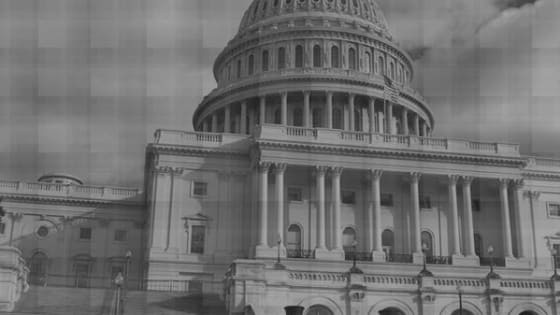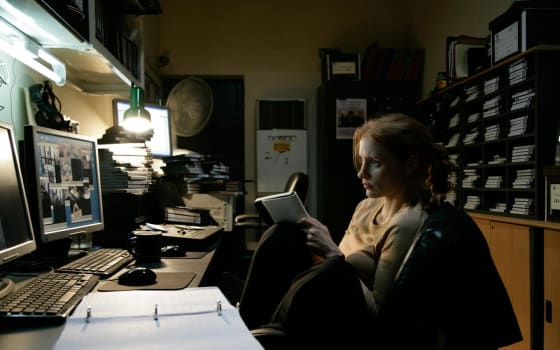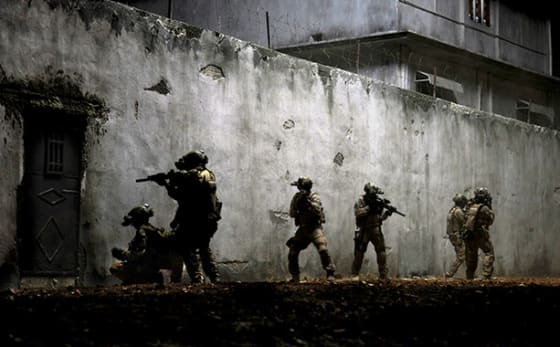The Politics of Zero Dark Thirty

Columbia Pictures
“You don’t want to be the last one holding a dog collar when the oversight committee comes,” CIA officer Dan cautions Maya in Zero Dark Thirty. The importance of secrecy is central to the film’s plot and its publicity, both of which have been wrought with controversy. From the inception of the screenplay immediately after bin Laden’s death to the nationwide opening last week, Zero Dark Thirty has been accused of misrepresenting what happened in the decade leading up to bin Laden’s death. Even now in the midst of award season, the real story behind the movie is just coming to light.
A QUESTION OF TORTURE
Pre-release judgments of the film claimed that it would serve as a tool for Barack Obama’s re-election in 2012 by giving the President credit for the historic discovery of Osama bin Laden on May 1, 2011. The limited release, initially scheduled for October 2012, was eventually pushed to December to avoid allegations of political bias. Ironically, the only appearance Obama makes in the film is his televised condemnation of the use of torture to extract information from detainees. Executive Order 13491, issued by President Obama in early 2009, immediately prohibited inhumane treatment, torture, and “outrages upon personal dignity.”
Both the protagonists of the Zero Dark Thirty, as well as the film itself, owe their successes in great part to this torture. The first act of the film is defined by scenes of detainees being questioned via various coercive techniques: waterboarding, sleep deprivation, humiliation, and cramped enclosure, among others. As the plot hinges on the effectiveness of these “EITs” (enhanced interrogation techniques), many critics have accused the film of promoting torture as a valid means of intelligence-gathering. The subsequent controversy undoubtedly contributed to ticket sales. However, the real problem with Zero Dark Thirty is less a question of morality and more a question of whether the events shown actually led to the discovery of bin Laden.
The jury is still out on whether or not EITs played an important role in tracking down bin Laden. Peter Bergen, counterterrorism adviser and author of Manhunt: The Ten Year Search for Bin Laden from 9/11 to Abottabad, wrote an op-ed for CNN describing the disingenuous narrative surrounding the torture scenes:
“Zero Dark Thirty will be released at a time when Americans are becoming more likely to embrace the idea that torturing prisoners suspected of terrorism is justified.”
Marty Martin, a former senior intelligence official in the CIA, had this to say of the torture scenes:
“It’s absolutely wrong. The torture stuff was totally inaccurate and did not happen that way. It was much more systemic, clinical, and professional. Obviously, it’s a very controversial topic, and people do need to understand that that program absolutely contributed to saving lives, but it did so combined with a global effort.”
Despite the purported inaccuracy, Zero Dark Thirty continues to be marketed and sold on the idea that it is based on first-hand accounts. Director Kathryn Bigelow and screenwriter Mark Boal admittedly worked with CIA operatives and other government officials in writing the story. This has sparked an even bigger dispute about their access to sensitive information, the release of which could allegedly risk national security and future operations.
CHECKS AND BALANCES IN HOLLYWOOD
In January 2012, when conservative watchdog group Judicial Watch was denied access to information pertinent to Zero Dark Thirty‘s production, they filed a lawsuit against the Department of Defense and the CIA claiming that all requests for such information should be fulfilled under the Freedom of Information Act. In August of 2012, a court order finally gave Judicial Watch access to records between the CIA and the filmmakers. Included were exchanges between CIA advisors and Bigelow, records of her visit to CIA headquarters, and floor plans of bin Laden’s Abbottabad compound.
The government has been even slower to question the lawfulness of the filmmaking. Peter King, Congressman and Chairman of the House Committee on Homeland Security, first called for a deeper look into the relationship between the CIA, DOD, and the filmmakers back in 2011, but it wasn’t until the day of the film’s release that any investigation commenced. On December 19, 2012, Senators Dianne Feinstein, John McCain, and Carl Levin (all members of the Senate Select Committee on Intelligence) sought a change to the film’s narrative in a letter to Michael Lynton, Chairman and CEO of Sony Pictures Entertainment:
“…with the release of Zero Dark Thirty, the filmmakers and your production studio are perpetuating the myth that torture is effective. You have a social and moral obligation to get the facts right.”
Dated the same day as their letter to Lynton, the Comittee sent an appeal of a different type to CIA acting director Michael Morell. They accuse Morell of disclosing information pertinent to the hunt for bin Laden to the filmmakers of Zero Dark Thirty. They were made aware of this correspondence via “publicly released CIA email.”
Unless there is a different batch of publicly released CIA emails—which, with this kind of transparency, would not be out of the realm of possibility—the Senators are referring to the very same emails given to Judicial Watch under the Freedom of Information Act. As a result of the film’s falsehoods and their awareness of the CIA’s role in the production of the film, the Senators ask Morell for all communication records between the CIA and the filmmakers.
Just two days later on December 21st, Morell publicly denounced Zero Dark Thirty in an official CIA press release. He accused the film of giving the “strong impression that the enhanced interrogation techniques… were they key to finding Bin Ladin.” While he says this impression is false, he stops short of saying that EITs were completely ineffective. Not about to be satisfied, the Senators sent one more letter asking Morell to elaborate on the efficiency of EITs used on detainees. The details since then have been limited, as the investigation is ongoing, but former CIA Director Leon Panetta and DOD Undersecretary of Defense Michael Vickers are among those under review for a possible breach of classified information.
Despite the fact that Judicial Watch’s actions were motivated by an agenda to render Obama as careless and irresponsible, there is a point to be had in how little is known about the cooperation between the administration and the filmmakers. Bigelow uses this as a selling point in promotional interviews for the film. When asked about the accuracy of the intelligence given to her by cooperating agents, she cryptically answered:
“I think it’s a fair assessment of the events of those times. Now, will there be more information that will come to light, once the Senate report is declassified? I mean, I welcome all this information. This is based on first-hand accounts that we were able to glean over the course of the last year.”
Zero Dark Thirty is hardly a propaganda film, but the special privileges given to Bigelow and Sony Pictures suggests that either the Obama administration or the CIA had something to be gained by publicizing previously classified information. Even if the covertness of production was only a pretense to give the film an air of mystery and authenticity, manipulating the government’s public image is never a justifiable way to sell movie tickets.
Columbia Pictures
A ONE-WOMAN TEAM EFFORT
One of the most provocative questions the film raises is one whose answer may damage the credibility it has worked so hard to forge: does the real CIA agent the main character is based on even exist? For the entirety of the movie, Maya, played by Jessica Chastain, is shown to almost single-handedly track down bin Laden from a few tight-lipped detainees all the way to his compound in Abbotabad eight years later.
Because of EITs and a comprehensive assessment of their connections to al Qaeda, she discovered the importance and identity of Abu Ahmed, one of bin Laden’s most trusted couriers. With the information afforded to the public as of now, the existence of the real “Maya” cannot be corroborated, much less the name and gender of such an individual. A more realistic characterization is given by Nada Bakos, a CIA analyst who tracked down al Qaeda envoy Hassan Ghul:
“It’s not just one beautiful redhead. It’s more than two data points of collection, and Zero Dark Thirty makes it look like a Sherlock Holmes mystery. And before ‘Maya’ was assigned to the case, the plot line on the bin Laden courier had already been developed by other analysts.”
It is unlikely that a single person, whose tireless work went unnoticed and whose admonitions often fell on deaf ears, steered the course of an entire military operation. Maya is more likely a composite of several female and male CIA analysts. The group effort was personified in one woman for narrative simplicity, marketability, and to utilize the classic underdog character type whose perseverance and patriotic sense of duty would be undeniably seductive to American audiences.
THE LEGACY OF ZERO DARK THIRTY
At last Wednesday’s Senate Foreign Relations Committee’s hearing regarding September’s terrorist attack in Benghazi, Secretary of State Hillary Clinton regretted the fact that the United States has relinquished all broadcasting in the Middle East. This leaves the country vulnerable to potentially damaging narratives.
A key component of public relations in the 21st century is telecommunications and new media. If the government ignores these outlets, our international reputation will be constructed from militant extremist propaganda and the film industry. Filmmakers must be aware that what they put out there has global ramifications. If we abdicate ourselves from self-representation in other countries, then we must accept that our voice will be replaced by Hollywood exports that could be extremely damaging in the context of other cultures.
There is currently no way to be sure who tracked bin Laden, to what extent EITs played a role, and how much the administration cooperated with Bigelow and Sony Pictures in the production of the film. In any case, the confusion of the facts, disagreement among public officials, and public display thereof is not symptomatic of government transparency. The most innocuous scenario is that the entire production and ensuing media coverage was solely meant to lure audiences to the box office. The more harmful possibility is that the government remains selective in its dispensation of information, the relationship between the federal legislature and the CIA remains strained, and the only record we will have of the raid on bin Laden’s compound is a Hollywood movie whose ethics are questionable, at best.
The Zero Dark Thirty Controversy, Explained
Kathryn Bigelow’s 2012 film “Zero Dark Thirty,” which starred Jessica Chastain as CIA analyst Maya Harris and depicted the hunt for al-Qaeda leader Osama bin Laden, was nominated in a handful of categories at the 2013 Academy Awards and went home with an Oscar for best sound editing. However, it’s most remembered for the controversies that surrounded it.
When the United States became involvement in Iraq, Afghanistan, and began the general War on Terror during George W. Bush administration, many curious things happened to popular culture. Some artists and audiences who opposed the military actions looked back to protest songs of the Vietnam War, or to the punk backlash against Ronald Reagan, and took a deep sigh and repeated the mantra, “At least we’ll get some good art out of this.”
This is a phrase often heard in times of political upheaval. As citizens, we may have lost power of a brazenly corrupt government, or a violent and frustratingly automated military machine that is spinning into torture and lies, but we do — at the very least — have control over how we talk about it and criticize it in out art. Surely this would be a time of angry pop music opposing the famously messy and subterfuge-infused military actions in the Middle East.
And while there was protest music during this era, the pop landscape was more often lifting up angry revenge ballads (look up the lyrics to Toby Keith’s hit song “Courtesy of the Red, White, and Blue (The Angry American)”) and making movies about how this was just “a confusing time.” It wouldn’t be for a while that we learned the full extent of the lies and horrors involved in the war, something we’re still sifting through.
It would take years before our views on this era would be clear, and “Zero Dark Thirty,” while highly awarded, was not welcomed with open arms by audiences, due to its views that appeared to advocate torture.
The Simple Narrative
Jessica Chastain in Zero Dark Thirty
Sony Pictures
“Zero Dark Thirty” was immediately a lightning rod for controversy, inspiring a litany of examinations from critics and editorialists as to its accuracy, and, more importantly, its attitude about the war. The film was made, after all, during the Obama administration which oversaw the May 2nd, 2011 Abbottabad raid that killed Osama bin Laden. For many, this was the end of the conflict. A simple narrative formed: A bad man attacked America, we used some dodgy means of finding him, but find him we did, and he was executed by our military. Going back and delving into those dodgy means was not something everyone was so interested in, and the Toby Keiths of the world were validated.
During the length of the conflict, however, one might have noticed more and more images of torture leaking into popular entertainment, to the point where it was almost normalized. Hit shows like “24” (which debuted in November of 2001) regularly argued that torture was a swift and efficient way to obtain information. In 2004, the torture pictures from Abu Ghraib were released to the public, and it’s a timely coincidence that the “Saw” film series began only a few months later. The bulk of the 2000s was inundated with a new horror genre, nicknamed torture porn, and images and conversations about the manner and ubiquity of torture proliferated through our cynical, tired-out minds, leaving a sticky residue of outrage and resentment.
This normalization of torture images was tolerated for two reasons: One, seeing in a horror context it helped to remind us that we, as a nation, were involved in something shocking and that it shouldn’t become easy-to-consume action movie fodder. And two, many Americans felt this was the Only Way to get what we needed. It was sold as a dark necessity, and popular entertainments were serving as an apology for the nation’s latest sine qua non.
Was It An Apology?
Joel Edgerton in Zero Dark Thirty
Sony Pictures
Enter “Zero Dark Thirty” a film that openly featured scenes of torture. I think we’re all sophisticated enough to understand the basic film tenet that depiction does not equal advocacy, but many felt that depicting torture at all in a based-on-real-events military thriller was tacky at best and irresponsible at worst. Naomi Wolf, in The Guardian, wrote an open letter to Bigelow pointing out that her depiction of torture without criticism or context turned her into a propagandist for the military state, and even going so far as to compare Bigelow to Nazi propagandist Leni Riefenstahl: “It makes heroes and heroines out of people who committed violent crimes against other people based on their race — something that has historical precedent.”
Kathryn Bigelow defended herself during the controversy by describing herself as a combination filmmaker and journalist. It was her goal, she said, to merely record what happened as it happened, without judgment. Even if it was a fictionalized narrative, and the perspective was mostly from the character of Maya Harris. She wasn’t apologizing or advocating for torture. But it did happen and she was, as she explained, merely relating the truth.
That narrative, by the way, moved the story of “Zaro Dark Thirty” from one of the CIA or one of the military to that of a single, doggedly determined CIA agent. Maya is given typically zealous, violent language like “I’m gonna kill bin Laden!” and the film becomes a cycle of torture to get information, that information not coming quite quickly enough, another terrorist attack, hasty arrests, more torture, etc. The film essentially becomes — broadly speaking — a race for Maya to find torture-based information quickly enough to find Osama bin Laden. She may be seen as an avatar for the CIA in general … but not really. “Zero Dark Thirty” was seen as a way to deflect the real-life military violence of the United States onto a figurehead for American frustrations. In making the film about her own personal vendetta and her frustration in not getting revenge fast enough … well, that sort of ties into justifying America’s own bloodlust and willingness to forgive torture as a means to achieve it, doesn’t it?
Was the CIA Involved?
Joel Edgerton
Sony Pictures
But the controversy went deeper than film theory and depiction vs. advocacy. Yes, as it turns out, the CIA was involved in the making of “Zero Dark Thirty.”
As detailed in an article on The Ringer: Thanks to a conservative group called Judicial Watch, e-mails between the White House and the Pentagon were eventually uncovered, revealing their involvement in this film. It’s worth stating at this juncture that any and all films that depict the military are typically made with the military’s involvement (often in order to gain access to vehicles, uniforms, etc.), so some military involvement in a film like “Zero Dark Thirty” is typical and expected. What is not expected is that the CIA was also involved, aiding Bigelow and screenwriter Mark Boal in the construction of the film. No, the CIA wasn’t offering screenplay notes, but Boal and Bigelow were relying on the CIA’s version of events — and perhaps general attitudes they dictated — to make “Zero Dark Thirty.” This means that Bigelow wasn’t constructing a narrative based on her point of view, but was making a movie specifically to advance the CIA’s point of view — a point of view that, we now know, was riddled with lies and obfuscation.
Bigelow, in trying to remain objective, may have been wittingly or unwittingly pushing actual CIA propaganda. For as thrilling as the film may be — and for as accurate as its vengeful attitudes of the American public may have been — it was essentially based on an oversimplified version of events that was making a general apology (or at least a justification) for torture and other illegal military maneuvers.
“Zero Dark Thirty” is a thrilling film, but it would be wise to take it less as an immediate history of the events of 2001 to 2011, and more a general encapsulation of attitudes at the time. How we were angry, adrift, and some of us were openly willing to put a boot up someone’s ass, a la Toby Keith.
Read More: https://www.slashfilm.com/671508/the-zero-dark-thirty-controversy-explained/?utm_campaign=clip

